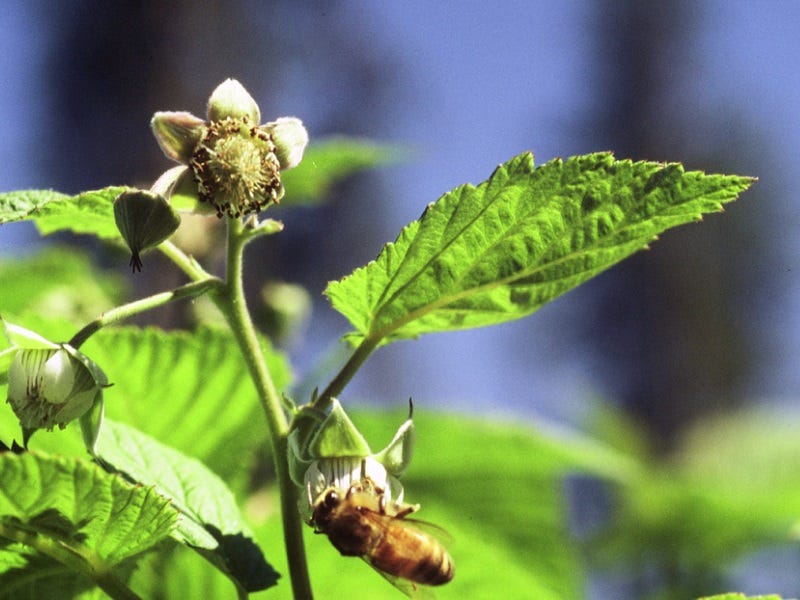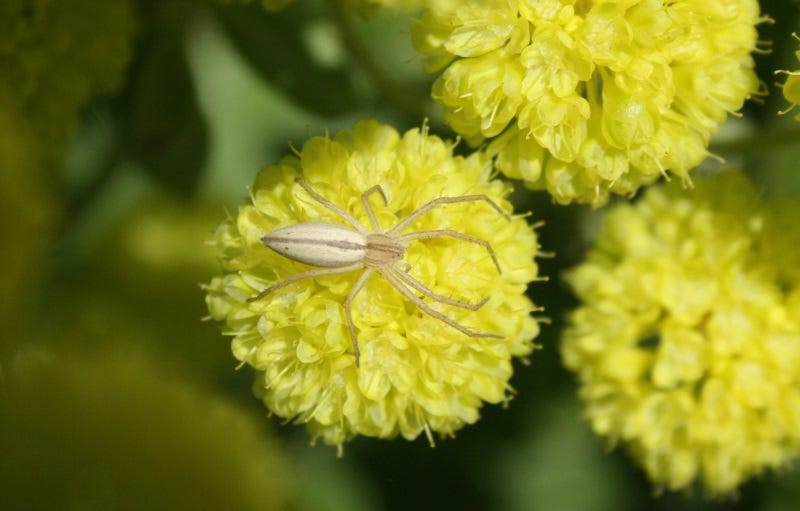Bringing in the Good Guys


One of my favorite summer activities is to sit outside and listen to the garden. When it’s alive with the sound of buzzing, chirping, and singing, I know all is well in our little microcosm. In the end, having an array of insects, along with a healthy number of birds, is the ideal mix for a productive and low-stress garden, not to mention a nice mindset.
We all understand the role that honeybees play in the garden, with their hard work flying from flower-to-flower so we don’t have to hand-pollinate our squash and other vegetables. But there are a multitude of other insects that share this task. On top of that, there are a whole band of other insects, as well as birds, that will take care of a lot of your pest problems before they become an issue. The key is creating a suitable landscape for all.
 Spiders are a great help in the garden.
Spiders are a great help in the garden.Going beyond honeybees
Honeybees are great Yet, they aren’t the only ones who you want in your garden. In reality, they’re not even the best pollinators out there. Beyond the non-native honeybees, we have nearly 400 species of native bees in North America, many of which are far better suited for our climate. You’ll see bumblebees out early in the spring, even in inclement weather, pollinating Nanking cherries and other early blooming shrubs and perennials while the honeybees are waiting out the storm in their hives.
Bumblebees are also well-known for buzz pollination where they grasp a flower, like one on a tomato, and buzz in the tune of middle C. This causes the anthers, which are often out of reach of their bulky, fuzzy bodies, to release the pollen. It falls all over the bees, and they are off to the next flower. We can cause the flowers to release their pollen in a similar fashion with a tuning fork, but I am grateful the bumblebees do it so much more efficiently.
Solitary bees, such as the mason or leaf-cutter bees, are equally helpful in the garden. The greatest difference with these native bees is their timing. Mason bees are typically out earlier in the season pollinating crops in the spring and the first part of summer, where the leaf-cutters handle more of the squash and later season vegetables. Both are better at pollinating than honeybees because they tend to flop in the flower instead of carefully gathering pollen, so it’s important to encourage them to take up residence in our gardens.
 Predaceous ground beetles are one of the good guys
Predaceous ground beetles are one of the good guysCalling in the good guys
Beyond pollination, it makes sense for us to create a situation where beneficial insects, the ones that eat the pests that eat our plants, handle the bulk of our problems for us. The reality is, if we create a balance within the garden, we won’t need to use a lot of the chemicals (even natural ones), saving us time and money, as well as the worry about poisoning our foods.
Ladybugs are probably the best known beneficial insect, and you can buy them by the hundreds or thousands. The reality is the adult ladybugs aren’t the voracious eaters they were when they were larvae, which is the stage you really want in the garden; plus, the adults typically leave shortly after they’re released. So while you can purchase ladybugs, it makes more sense to simply create a habitat where you have them live throughout the season.
 Native bees are important garden partners.
Native bees are important garden partners.Depend more on the native beneficials, such as predatory ground beetles, spiders, and parasitic wasps. The predatory ground beetles look tough because they are, especially if you’re a caterpillar or grub in their clutches. Spiders are known to capture and consume all sorts of flying insects, and they’re typically not picky about eating whatever flies into their webs. And parasitic wasps do a number on a lot of unwanted caterpillars by laying their eggs inside the paralyzed caterpillar; her young hatch and consume the unfortunate host from the inside out. Mother Nature does not play around.
Don’t forget the birds
Birds are another excellent pest eating resource to have in the garden. While they might hit the seeds and fruits later in the season, during spring and early summer most of them need high-protein sources, and insects fit that bill. If you have a wide array of birds in the garden they make a dent in the insects on your plants.
Make a safe place for the birds and bees
The first step in creating a landscaping where beneficial bugs and birds pollinate your plants and feed upon pests is understanding an acceptable level of pest pressure. This means basically not freaking out if you see an aphid or another pest. Beneficial insects need something to eat, like aphids, so there should be some in the garden. It’s only when the numbers grow out of control, to the detriment of the plant, that there is a problem.
Accepting some level of pest pressure also minimizes, or eliminates, the use of pesticides of any sort. That is a good thing because those chemicals, while controlling bad bugs, also kill the good ones. When you use poison, even a natural kind, you are potentially killing the bees and other insects that you need. So, be very conservative with their use.
 Dill is a tremendous plant to encourage beneficial insects.
Dill is a tremendous plant to encourage beneficial insects.Plant a variety
Insects and birds prefer a variety of plants in the gardens, so mix it up. Plant flowers among your vegetables to bring in the pollinators, as well as signal the beneficial insects that there are good places to hide. Some beneficial bugs, such as lacewings and ladybugs, like plants such as dill, angelica, and yarrow. Incorporate different plants and flowers in your garden to encourage a wide variety of insects.
Create a home
Obviously, you don’t need anything fancy for the birds and the bees, but when you provide some sort of shelter, you have a better chance of keeping them around. Learn what birds like your area and put up boxes before they begin nesting.
The same goes for native bees. Many of the solitary bees use small tube-like structures, which can be purchased or made, to lay their eggs for the next season’s generation of bees. Set out these simple nests to give them options.
 A mason bee nest encourages the solitary bees to stay in the garden.
A mason bee nest encourages the solitary bees to stay in the garden.Don’t forget the water
Just like all of us, the birds and insects need a source of water. While many of the bugs make do with what they find on the plants themselves, having a bird bath, small water feature, or simply running the sprinkler makes your bird neighbors very happy. Do this early in the morning or in the evening to maximize benefits.
Think big picture
Bringing in the birds and bees to your garden not only makes your life easier, it makes it more enjoyable. Take a moment to pull up a chair, grab a cup of coffee, and sit outside during a summer morning. Listen to all the activity happening in your flowers and vegetables with the knowledge that they are working hard so you don’t have to.
